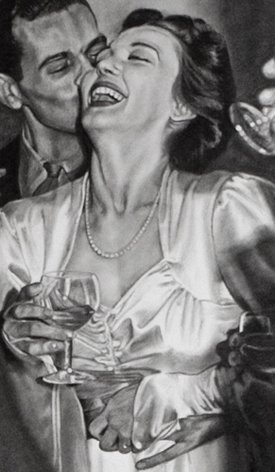-
Now almost entirely faded from collective memory, the actress Carole Landis was a doyenne of 1940s Hollywood. She’s a recurring image in Fowler’s archive. Paying tribute to Landis’s troubled life and tragic death, the large-scale drawing Chronicle of a Death Foretold comprises two deliberately juxtaposed images split across the portrait composition. The top image is taken from a press still of the actress on her wedding day (1943) to her fourth husband, United States Army Corps Captain Thomas Wallace. The bottom half of the composition is taken from a press image of Landis after she committed suicide in July 1948, aged just 29.
At the time of her death, Landis was ostracised in Hollywood. Ostensibly the result of her ardent feminism, rumours of sexual peccadilloes, a stalled career, poor health, failed marriages and financial problems, it is widely believed that Landis’s suicide was in fact a consequence of her married lover Rex Harrison’s refusal to leave his wife. The photo of Landis lying dead on her bathroom floor, having overdosed on the barbiturate Seconal, became her defining image. Its presence overshadowed the memory of her acting career. Newspapers ran the lurid print of a doctor kneeling over her corpse accompanied by the headline “The actress who could have been… but never was.”
The title of Fowler’s work pays homage to Gabriel García Márquez’s 1981 novel Crónica de una Muerte Anunciada, which recounts the failure to prevent a death in spite of it having been predicted. The allusion draws parallels with Carole Landis’s demise, played out in the glare of media flashbulbs and the heat of public speculation. In the drawing, the viewer is shown a lifetime led in front of the camera’s gaze — the spectacle of a woman whose life was not her own.
Featured in Measuring Elvis, 2015
Read further writing and essays in response to the subjects and themes relating to the work of Nina Mae Fowler here.

